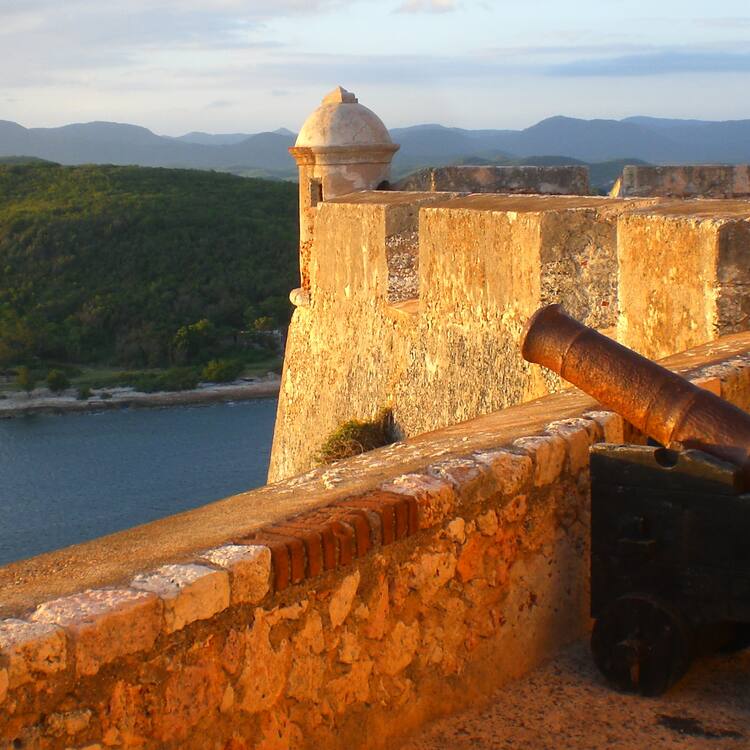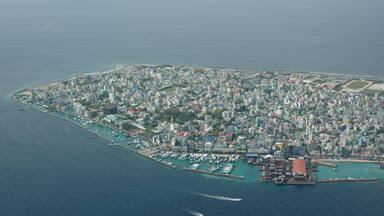San Pedro de la Roca Castle, Santiago de Cuba
San Pedro de la Roca Castle, Santiago de Cuba
Commercial and political rivalries in the Caribbean region in the 17th century resulted in the construction of this massive series of fortifications on a rocky promontory, built to protect the important port of Santiago. This intricate complex of forts, magazines, bastions and batteries is the most complete, best-preserved example of Spanish-American military architecture, based on Italian and Renaissance design principles.
Description is available under license CC-BY-SA IGO 3.0
Château de San Pedro de la Roca, Santiago de Cuba
Les rivalités commerciales et politiques dans la région des Caraïbes au XVIIe siècle ont abouti à la construction de cette série massive de fortifications sur un promontoire rocheux, afin de protéger l'important port de Santiago. Cet ensemble compliqué de forts, de magasins, de bastions et de batteries est l'exemple le mieux préservé d'architecture militaire hispano-américaine basée sur des principes de conception d'origine italienne et de style Renaissance.
Description is available under license CC-BY-SA IGO 3.0
قصر سان بيدور دي لا روكا، سانتياغو
أدّت الخصوم التجاريّة والسياسيّة في منطقة الكاريبي في القرن السابع عشر إلى بناء هذه السلسلة العظيمة من الحصون على نتوء صخريّ لحماية مرفأ سانتياغو العظيم. يُشكّل هذا المجموع المعقّد من القلاع والمتاجر والحصون وسريّة المدفعيّة المكان الأفضل صيانةً في الهندسة العسكريّة الإسبانيّة الأمريكيّة المبنيّة على مبادئ البناء الإيطالي الأصل والنهضوي الطراز.
source: UNESCO/CPE
Description is available under license CC-BY-SA IGO 3.0
古巴圣地亚哥的圣佩德罗德拉罗卡堡
17世纪,加勒比海地区商业和政治竞争促使人们在坚如岩石的海岬上修建了这一规模庞大的防御工事,用以保护重要港口圣地亚哥。 这一复杂的建筑群是根据意大利文艺复兴原理设计的,包括有堡垒、军火库、棱堡和炮台,是西班牙裔美洲人的军事建筑中保存最完整、最好的一个。
source: UNESCO/CPE
Description is available under license CC-BY-SA IGO 3.0
Крепость Сан-Педро-де-ла-Рока в городе Сантьяго-де-Куба
Торговое и политическое соперничество в Карибском регионе в XVII в. сделало строительство мощного комплекса укреплений, расположенных на скалистом мысе, необходимым для защиты важного порта Сантьяго. Сложный комплекс фортов, складов, бастионов и батарей – это наиболее целостный и хорошо сохранившийся пример испано-американской военной архитектуры, основанной на принципах проектирования итальянского Возрождения.
source: UNESCO/CPE
Description is available under license CC-BY-SA IGO 3.0
Castillo de San Pedro de la Roca en Santiago de Cuba
Las rivalidades comerciales y políticas en la región del Caribe durante el siglo XVII tuvieron por resultado la construcción de este castillo, conjunto masivo de fortificaciones erigido en lo alto de un promontorio rocoso para proteger el importante puerto de Santiago. Este intrincado complejo de fuertes, polvorines, bastiones y baterías, edificado con arreglo a los principios de diseño de la Italia renacentista, es el ejemplo más completo y mejor conservado de la arquitectura militar española en América.
source: UNESCO/CPE
Description is available under license CC-BY-SA IGO 3.0
サンティアゴ・デ・クーバのサン・ペドロ・デ・ラ・ロカ城
17世紀のカリブ海地域では紛争関係が続いたため、サンティアゴという重要な港湾を防衛するために、岩の岬に重厚な城塞が建設されることとなった。要塞、弾薬庫、稜保、砲台などが入り組んだこの建造物は、イタリア人とルネサンスの設計原理に基づく、スペイン領アメリカでのもっとも完全な、またよく保存されている遺構である。source: NFUAJ
Kasteel van San Pedro de la Roca, Santiago de Cuba
De commerciële en politieke rivaliteit in het Caribisch gebied in de 17e eeuw, leidde tot de bouw van een enorme reeks forten op een rotsachtig voorgebergte. Ze werden gebouwd om de belangrijke haven van Santiago te beschermen. Het kasteel van San Pedro de la Roca en de bijbehorende forten en bastions vormen het meest complete, best bewaard gebleven voorbeeld van een Spaans-Amerikaanse militaire architectuur, gebaseerd op Italiaanse en Renaissance ontwerpprincipes. Het is gebouwd op een voorgebergte met steile kliffen van meer dan 20 meter hoog. Het terrein bestaat uit verschillende vestingonderdelen op een reeks terrassen boven elkaar, verbonden door een reeks trappen.
Source: unesco.nl
Outstanding Universal Value
Brief synthesis
San Pedro de la Roca Castle, a multi-level stone fortress built into a rocky promontory (El Morro) at the south-eastern end of the island of Cuba, has guarded the entrance to Santiago de Cuba Bay since 1638. This exceptional fortress and its associated defensive works were constructed in response to the aggressive commercial and political rivalries that menaced the Caribbean during the 17th and 18th centuries; today, they constitute the largest and most comprehensive example of the principles of Renaissance military engineering adapted to the requirements of European colonial powers in the Caribbean. A classic bastioned fortification in which geometrical form, symmetry and proportionality between sides and angles predominate, the Castle is an outstanding representative of the Spanish-American school of military architecture.
San Pedro de la Roca Castle and its associated batteries of La Estrella, Santa Catalina and Aguadores protect the entrance to the bay and port of San Diego de Cuba, which was of great importance because of its geographical situation, its favourable currents and its protected anchorages. As conflicts between Spain and England grew in the 17th century, the town’s governor ordered the construction of a stone fortress on a strategic point where an earlier ravelin existed, following the designs of the renowned Italian military engineer Juan Bautista (Giovanni Battista) Antonelli. The fortress was built into the promontory’s steep cliffs in a progression of terraces, one above another, linked by a series of stairways. At the lowest level, just above high-water mark, is a fortified gun platform, powder magazine, command building and guard post. Next is the Santísimo Sacramento Platform, which includes gun emplacements, a powder magazine and quarters for its garrison. Above it are the El Aljibe, De Adentro and Napoles platforms. This part of the castle took its present form during a mid 18th-century reconstruction, when the North and South Bastions were added. The Santísima Trinidad Platform is the highest level of the main castle, and was built in the 1660s. To the north lies La Avanzada Fort, which completes the chain of smaller defensive works down the north side of the promontory, consisting of La Estrella Fort and two smaller forts built in the 1660s. Added later were the Semaphore Tower, the Chapel of Santo Cristo and the Lighthouse, all built in 1840, and two batteries, Scopa Alta and Vigia, built in 1898. The fortress – which has been repaired, reconstructed and consolidated numerous times due to earthquakes and attacks – declined during the early 20th century due to lack of maintenance, but was restored in the 1960s. This intricate complex of forts, magazines, bastions and batteries, all based on Italian and Renaissance design principles, is today the most complete and best-preserved example of this Spanish-American school of military architecture.
Criterion (iv):Constructed in response to the aggressive commercial and political rivalries that menaced the Caribbean during the 17th and 18th centuries, the Castle of San Pedro de la Roca and its associated defensive works are of exceptional value because they constitute the largest and most comprehensive example of the principles of Renaissance military engineering adapted to the requirements of European colonial powers in the Caribbean.
Criterion (iv): The Castle, a classic bastioned fortification in which geometrical form, symmetry and proportionality between sides and angles predominate, is an outstanding representative of the Spanish-American school of military architecture.
Integrity
Within the boundaries of San Pedro de la Roca Castle, Santiago de Cuba, are located all the elements necessary to express its Outstanding Universal Value, including the Castle fortress complex and its associated forts, magazines, bastions and batteries, as well as the rocky promontory El Morro on which the Castle is located. (Not all the elements that make up the property have been fully documented.) The 94 ha property is of sufficient size to adequately ensure the complete representation of the features and processes that convey the property’s significance, and it does not suffer from adverse effects of development and/or neglect.
Many aggressive atmospheric agents and sources of pollution have been registered that may threaten or damage the property, as well as its environment.
Authenticity
The authenticity of San Pedro de la Roca Castle, Santiago de Cuba, is high in terms of location and setting, forms and designs, and materials and substances. It underwent little change from the late 19th century, when its use as a fortress ceased, to the 1960s, when restoration work was undertaken according to the 1964 Venice Charter.
A number of conservation problems were noted in 1997. The most serious related to the wooden elements of the monument, where the choice of inappropriate timbers combined with pest attack resulted in severe degradation. The eroded walls needed stabilisation treatment, the vaults beneath the Santísimo Sacramente Platform required consolidation, and there was unsightly and potentially damaging vegetal growth in many of the walls.
The property is in an active seismic zone (Site Class A, hard rock).
Protection and management requirements
San Pedro de la Roca Castle, Santiago de Cuba, is owned by the Cuban state. The responsible national agency is the Consejo Nacional del Patrimonio Cultural (National Council of Cultural Heritage). The inscribed property is protected by provisions in the Constitución de la República de Cuba (Constitution of the Republic of Cuba) of 24 February 1976 and by National Monuments Commission Resolutions 9/1979 and 147/1997 designating it as a National Monument, in application of the Ley de Protección al Patrimonio Cultural (Law on the Protection of Cultural Property, Law No. 1 of 4 August 1977), and the Ley de Monumentos Nacionales y Locales (Law on National and Local Monuments, Law No. 2 of 4 August 1977). It is also part of Turquino Peak (Sierra Maestra) National Park. The property is managed by the Centro Provincial del Patrimonio Cultural de Santiago de Cuba (Provincial Centre for the Cultural Heritage of Santiago de Cuba), and the Castle has been occupied by the Museo de la Pirateria (Piracy Museum) since 1978.
The National Park in which the inscribed property is located has a management plan that takes into account the cultural sites within the park, as well as tourism pressures. In addition, a plan was prepared in 1994 for the monument itself by the provincial Technical Office for Monuments and Historic Sites and the provincial Physical Planning Administration. This plan has been approved by the municipality of Santiago de Cuba.
Sustaining the Outstanding Universal Value of the property over time will require registering and documenting all the elements that make up the property; addressing the identified and potential agents and sources of pollution that threaten the property and its environment; undertaking appropriate conservation interventions related to the severe degradation of the wooden elements of the monument; stabilising eroded walls; consolidating the vaults beneath the Santísimo Sacramento Platform; removing any potentially damaging vegetal growth in the walls; preparing a risk reduction and emergency preparedness plan for this active seismic zone; and establishing monitoring indicators related to these and other actions that may have an impact on the Outstanding Universal Value, authenticity and integrity of the property.

 View photos from OUR PLACE the World Heritage collection
View photos from OUR PLACE the World Heritage collection